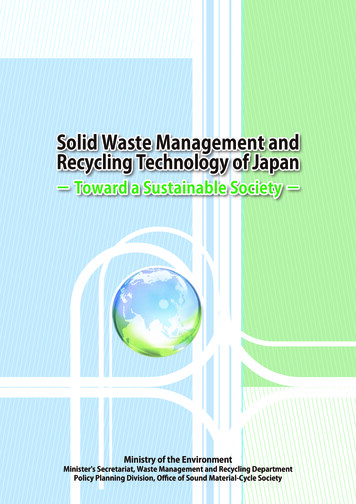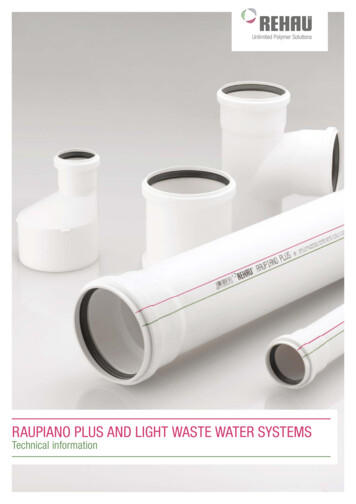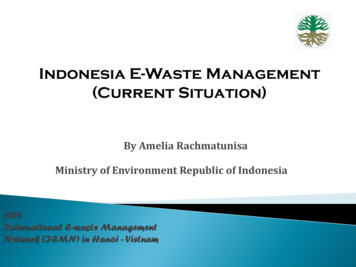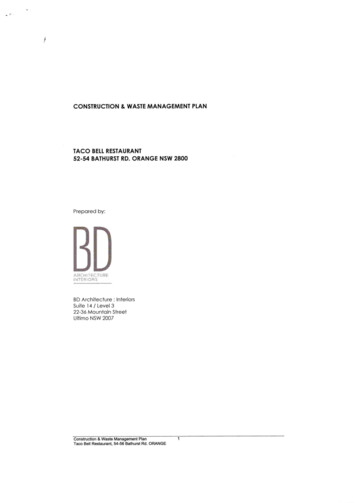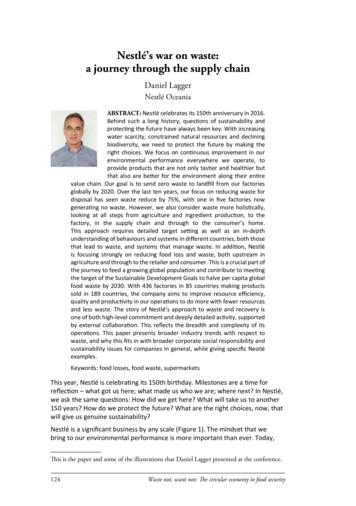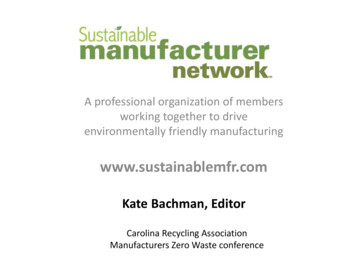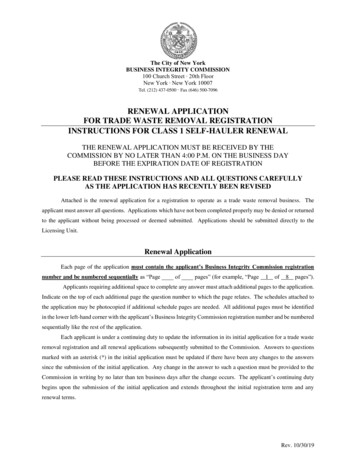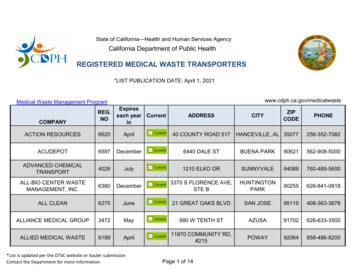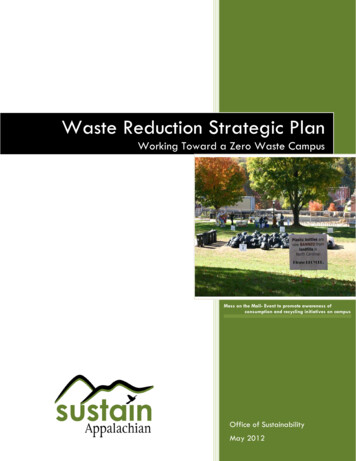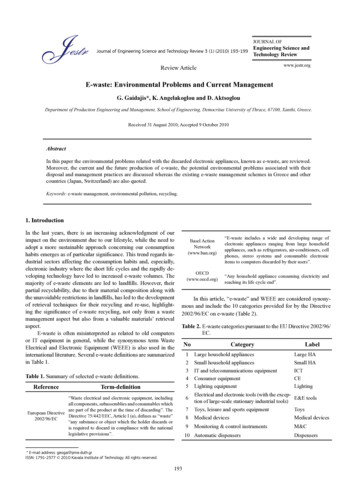
Transcription
JOURNAL OFEngineering Science andJournal of Engineering Science and Technology Review 3 (1) (2010) 193-199Technology Reviewwww.jestr.orgReview ArticleE-waste: Environmental Problems and Current ManagementG. Gaidajis*, K. Angelakoglou and D. AktsoglouDepartment of Production Engineering and Management, School of Engineering, Democritus University of Thrace, 67100, Xanthi, Greece.Received 31 August 2010; Accepted 9 October 2010AbstractIn this paper the environmental problems related with the discarded electronic appliances, known as e-waste, are reviewed.Moreover, the current and the future production of e-waste, the potential environmental problems associated with theirdisposal and management practices are discussed whereas the existing e-waste management schemes in Greece and othercountries (Japan, Switzerland) are also quoted.Keywords: e-waste management, environmental pollution, recycling.1. IntroductionIn the last years, there is an increasing acknowledgment of ourimpact on the environment due to our lifestyle, while the need toadopt a more sustainable approach concerning our consumptionhabits emerges as of particular significance. This trend regards industrial sectors affecting the consumption habits and, especially,electronic industry where the short life cycles and the rapidly developing technology have led to increased e-waste volumes. Themajority of e-waste elements are led to landfills. However, theirpartial recyclability, due to their material composition along withthe unavoidable restrictions in landfills, has led to the developmentof retrieval techniques for their recycling and re-use, highlighting the significance of e-waste recycling, not only from a wastemanagement aspect but also from a valuable materials’ retrievalaspect.E-waste is often misinterpreted as related to old computersor IT equipment in general, while the synonymous term WasteElectrical and Electronic Equipment (WEEE) is also used in theinternational literature. Several e-waste definitions are summarizedin Table 1.Basel ActionNetwork(www.ban.org)OECD(www.oecd.org)“Any household appliance consuming electricity andreaching its life cycle end”.In this article, “e-waste” and WEEE are considered synonymous and include the 10 categories provided for by the Directive2002/96/EC on e-waste (Table 2).Table 2. E-waste categories pursuant to the EU Directive 2002/96/EC.Table 1. Summary of selected e-waste definitions.Reference“E-waste includes a wide and developing range ofelectronic appliances ranging from large householdappliances, such as refrigerators, air-conditioners, cellphones, stereo systems and consumable electronicitems to computers discarded by their users”.Term-definition“Waste electrical and electronic equipment, includingall components, subassemblies and consumables whichare part of the product at the time of discarding”. TheEuropean DirectiveDirective 75/442/EEC, Article I (a), defines as “waste”2002/96/EC“any substance or object which the holder discards oris required to discard in compliance with the nationallegislative provisions”.NoCategory1Large household appliancesLarge HA2345Small household appliancesIT and telecommunications equipmentConsumer equipmentLighting equipmentSmall HAICTCELighting6Electrical and electronic tools (with the excepE&E toolstion of large-scale stationary industrial tools)7Toys, leisure and sports equipment193Toys8Medical devicesMedical devices9Monitoring & control instrumentsM&C10 Automatic dispensers* E-mail address: geogai@pme.duth.grISSN: 1791-2377 2010 Kavala Institute of Technology. All rights reserved.LabelDispensers
G. Gaidajis, K. Angelakoglou and D. Aktsoglou / Journal of Engineering Science and Technology Review 3 (1) (2010) 193-199E-waste differs chemically and physically wise from urban orindustrial waste. It contains both dangerous and valuable materials requiring special treatment and recycling practices to avoid adverse environmental impact and harmful impact on human health.Retrieving the valuable and base metals is possible by recyclinge-waste, but the high labour cost and the strict environmental legislation have consolidated these activities’ implementation mostlyin Asian countries such as China and India [1] by use of obsolete methods and inadequate emphasis on the employees’ protection [2]. As a result, the e-waste disposal issue has attracted theinterest of politicians, non-governmental organizations, such asGreenpeace (www.greenpeace.org), Basel Action Network (www.ban.org), Silicon Valley Toxics Coalition (www.svtc.org) and thescientific community.air-conditioners etc.) are not included in the aforementioned calculation, it is estimated that the total e-waste quantities will be ratherlarger. If the global increase of GDP by approximately 20% in thelast 6 years is also considered, then the aforementioned estimate of20-50 Mt/year [3] is justified.Table 3. E-waste types and their estimated life cycle.ItemPersonal Computer (PC)aFax machinebHigh-fidelity systemcCell phonecElectronic gamescPhotocopierbRadiocTelevision (TV)dVideo recorder/DVD PlayercAir-conditionerbDish washercElectric cookercFood rigeratorcTelephonecToastercTumble DryercVacuum cleanercWashing machinec2. E-waste Production2.1 Current SituationThe global e-waste production is assessed at 20-50 Mt/year [3],equal to 1-3% of the estimated global urban waste production(1636 Mt) [4, 2]. PCs, cell phones and TVs will contribute 5.5 Mtin 2010 and will amount to 9.8 Mt in 2015. In wealthier countries,e-waste will stand for 8% of the urban waste volume [5]. Eachelectronic item’s participation in the annual e-waste production,E (kg/year), depends on each electronic item’s mass, M (kg), itsquantity (number) in the market and consumption, N, and its average life cycle, L (year).E MN/L(1)Electronic computers with an average 3-year life cycle [6]contribute to a greater extent to the total e-waste flow comparedto refrigerators and electrical cook-stoves, having an average lifecycle of 10-12 years. Certain e-waste types along with their massand estimated life cycle are summarized in Table 3.Particularly for the European Union, the e-waste quantitiesincrease by 3-5% per year [9], a rate three times faster than theurban solid waste. During the 1990-1999 period the quantities produced in EU-15 were approximately 3.3-3.6 kg/resident, while estimated quantities for the 2000-2010 period vary between 3.9-4.3kg/resident [5]. Using the equation (1), Swiss is estimated to produce 9 kg/person/year [10], the European population 14 kg/person/year [11], with the total EU-15 production amounting to 5.5 Mt/year and, in case of EU-27, 8.3-9.1 Mt/year [12]. USA producedapproximately 2.6 Mt [2], while China produced 2.5 Mt in 2005[13]. There are no available data for poorer countries, but it was assessed that India and Thailand produced 0.3 and 0.1 Mt of e-wastein 2007 [2].According to another calculation based on the equation (1),Tab.3 and available data for the total number of PCs (0.78 billionunits), cell phones (3.4 billion units), stationary phones (1.2 billionunits), TVs (1.4 billion units), and radios (2.5 billion units), thetotal production amounts to 11.7 Mt/year [7]. Moreover, considering the constantly increasing production of e-waste and the factthat the relatively large-mass electrical appliances (refrigerators,a[6], b [7], c [2], d [8].Mass ofItem edlife (years)351025810551210105101010371055101082.2 Future trendsThe global e-waste production is estimated to increase due tothe economic growth and the available technologies since the increased GDP leads to increased purchasing of electronic goods and194Figure 1. N umber of PCs per country related to the country’s GDP for 161countries (Source: [7]).
G. Gaidajis, K. Angelakoglou and D. Aktsoglou / Journal of Engineering Science and Technology Review 3 (1) (2010) 193-199eventually to increased e-waste production. For example, the totalnumber of PCs for each country is related to the country’s GDP(see Figure 1).The increasing economic growth is anticipated to reflect higher e-waste production as it is shown in Fig.1. On the contrary, it isanticipated that specific changes in the technology and the consumption habits are expected to decrease the global e-waste production, since consumers may favor more portable PC solutionshaving 1-3 kg average weight compared to the stationary computer weighing 25 kg, or the stationary computers is expected to beequipped with LCD (Liquid Crystal Display) screens instead of theolder CRTs (Cathode Ray Tube).3. Environmental Impacts3.1. Potential environmental problems related to e-wasteIn Figure 2, all possible e-waste routes and flows and their potential environmental impact are summarized. The chemicalcomposition of e-wastes depends on the type and the age of theelectronic object discarded. It is usually predominated by several metal alloys, especially Cu, Al and Fe attached to, coveredwith or mixed with several plastics or ceramics. The differentsubstances-elements-pollutants related to e-waste are presentedin Table 4. Some of them, such as heavy metals, are used in theproduction of electronic items, while others, such as PolycyclicAromatic Hydrocarbons (PAHs) are produced by e-waste burningat low temperature. Burning the isolating plastic cover of cablesin open barrels produces 100 times more dioxins than domesticwaste burning [14].Considering that the annual e-waste production approximates 20Mt, the total quantities of the several pollutants containedin the e-waste flow result, to a great extent, in landfills or recyclingcentres affecting the environment and/or public health. Therefore,despite significant recycling, e-waste is liable for 5000 t Cu annually released to the environment [17]. PBDEs (Polybrominateddiphenyl ethers) are combustion retardants that finally result inthe environment and, given that they are lipophilic compounds,are bioaccumulated in living organisms [18], while the refrigerators and air-conditioners discarded contain CFCs (Chlorofluorocarbons) that will eventually destroy the ozone layer when, in theTable 4. Potential environmental pollutants produced from e-waste management procedures.Occurrence ine-wasteSubstanceTypical concentration Global emissions (tons)bin e-waste (mg/kg)aHalogenated compounds:PCBCondensers, TransformersTBBA, PBB, PBDEFire retardants for plastics (thermoplastic components, cable insulation)CFCCooling unit, Insulation foamPVCCable insulation142801,70034,0001803,600Heavy metals and other metals:AntimonyFire retardant, plasticsArsenic (As)Small quantities in the form of gallium arsenide within light emitting diodesBarium (Ba)Getters in CRTBeryllium (Be)Power supply boxes which contain silicon controlled rectifiers and x-ray lensesCadmium (Cd)Rechargeable NiCd-batteries, fluorescent layer (CRT screens), printer inks and toners,photocopying-machines (printer drums)Chromium (Cr)Data tapes, floppy-disks9,900198,000Copper (Cu)Cabling41,000820,0002,90058,000Lead (Pb)CRT screens, batteries, printed wiring boardsLithium (Li)Li-batteriesMercury (Hg)Fluorescent lamps that provide backlighting in LCDs, in some alkaline batteries and mercury wetted switches0.6813.6Nickel (Ni)Rechargeable NiCd-batteries or NiMH-batteries, electron gun in CRT10,300206,000Rare Earth elementsFluorescent layer (CRT-screen)Selenium (Se)Older photocopying-machines (photo drums)Tin (Sn)Solder metal glue, LCD2,40048,000Zinc sulphideInterior of CRT screens, mixed with rare earth metals5,100102,000Others:Toner DustToner cartridges for laser printers / copiersRadio-active substancesMedical equipment, fire detectors, active sensing element in smoke detectorsAdapted from [15, 7]. a [16] b [7]195
G. Gaidajis, K. Angelakoglou and D. Aktsoglou / Journal of Engineering Science and Technology Review 3 (1) (2010) 193-199Figure 2. E-waste routes.future, CFCs escape from the e-waste dumping site [19].The aforementioned problems grow bigger considering thefact that the majority of e-waste are not recycled, because severalelectronic and electrical items are discarded along with householdwaste and are subject to no further treatment [20]. Approximately80% of the quantity collected for recycling is exported to countries such as China, India, Pakistan, Vietnam, Philippines, Malaysia, Nigeria, Ghana etc. [21]. This results in their treatment in veryloose environmental frameworks having increased impact on theenvironment and the employees in the specific operations. Nongovernmental organizations, such as Greenpeace, report this «secret flow» of e-waste [2].in developing countries (e.g. child labour, e-waste burning andemission of several pollutants to the air, leachate seepage in underground and surface aquifers etc.) the final environmental benefit-impact balance is not always positive. It must be also stressedout that any environmental benefit from recycling vanishes whenthe waste to be recycled is transported to great distance due tothe adverse environmental impact of the energy consumed for itstransportation [26], while, recycling, in any case, has smaller ecological footprint than e-waste dumping and burning [9].3.2 Environmental pollution caused by e-waste disposaland recycling4.1 GreeceThe majority of e-waste is led to (sanitary) landfill sites. Theimplementation of the appropriate, in this case, TCLP (ToxicityCharacteristic Leaching Procedure) test has showed that e-wastediscarded at urban waste dumping sites do not produce leachateswith heavy metals concentrations exceeding the environmentallimits [22]. Nevertheless, this chemical cocktail generated as leachate following the TCLP test from several electronic items wastoxic for aquatic organisms [23]. Moreover, the usual management practice of e-waste compression before or during discardingin landfills may increase the leachate volumes due to the disturbance of the several electronic circuit parts an
air-conditioners etc.) are not included in the aforementioned calcu-lation, it is estimated that the total e-waste quantities will be rather larger. If the global
